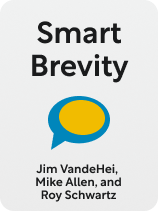

This article is an excerpt from the Shortform book guide to "Smart Brevity" by Jim VandeHei, Mike Allen, and Roy Schwartz. Shortform has the world's best summaries and analyses of books you should be reading.
Like this article? Sign up for a free trial here.
Are you struggling to capture your audience’s attention in today’s fast-paced digital world? Do you want to learn how to communicate more effectively in both personal and professional settings?
Smart Brevity, a book by Jim VandeHei, Mike Allen, and Roy Schwartz, offers a solution to these challenges. The book introduces a method for clear, concise communication that respects readers’ time while delivering impactful messages.
Keep reading to discover how you can apply these principles to improve your writing, social media presence, and workplace communication.
Smart Brevity Book Overview
In today’s world, if you want to be heard, you have to cut straight to the point. Traditional, long-form writing and presentations are no longer effective due to the digital age’s constant distractions and the modern audience’s limited attention spans. Even for the most prominent and widely read publications, readers largely skim their content and give up after the first few paragraphs. Has technology destroyed reading, or is there a better way to capture and retain your audience’s attention?
In Smart Brevity, a book published in 2022, Jim VandeHei, Mike Allen, and Roy Schwartz argue for a concise and direct approach to communication. They introduce a method of communicating that prioritizes clarity, concision, and audience engagement while respecting your readers’ limited time. Overall, their strategy calls for being direct, so you stand out from the chaos of our digital world and deliver something fresh and worthy of your reader’s attention.
VandeHei, Allen, and Schwartz are the cofounders of Axios, a media company known for concise news coverage. VandeHei and Allen previously worked together at Politico, where VandeHei served as executive editor and Allen authored the daily newsletter, Playbook. The authors’ extensive experience in journalism and media makes them experts in crafting engaging and informative content. VandeHei is also the author of Just the Good Stuff, a book on achieving success despite adversity.
We’ll explain why brevity and clarity in writing have become more important. We’ll show how you can improve your writing style using strong opening statements, putting information in context, and providing direction for readers who want more depth. We’ll show how these principles apply outside of traditional writing, such as in social media and interoffice communications, as well as how clear, concise communication can strengthen your organization as a whole.
We’ll also look at writing suggestions that agree with, build on, and occasionally contradict Smart Brevity’s authors’ advice. We’ll examine how reading and writing have evolved since the advent of digital media and consider alternatives to the communication tools VandeHei, Allen, and Schwartz present. We’ll hear from other experts on business communication and point to insights from marketing and leadership experts on how to tailor your messaging for colleagues and external audiences alike.
Why Be Brief?
In the digital age, we’re bombarded with content, which is why VandeHei, Allen, and Schwartz assert that most readers want you to make your point quickly. Like it or not, our information overload has diminished people’s willingness and ability to focus and read deeply. Instead, we follow tweets and Instagram posts, or skim headlines instead of reading news. Therefore you, as a writer, have to contend with your reader’s general lack of attention.
The authors argue that if you want to get your message across, you have to give up on intricate, wordy writing and consider what your reader actually needs to know. However, in our emails, press releases, and memos, we often bury our message under a deluge of words. While “long-form writing” caters to our desire to explain our thoughts in detail, it fails to convey anything because it isn’t adapted to the way the internet has trained readers to consume information. Research shows that internet users’ eyes only linger on any single image or link for a handful of seconds at most. Therefore, any information you want to get across has to do so in those few seconds.
Make Brevity Work
The question, then, is how to grab readers in today’s crowded information marketplace. The answer is to be brief, but well-reasoned, constructing your message in a way that saves your readers’ time and respects their intelligence. VandeHei, Allen, and Schwartz outline four components of a well-structured message: a tight, punchy writing style; a strong opening sentence; a concise explanation of why the content matters; and the option for the reader to find more information if they choose to explore your subject further.
Tighten Your Writing Style
Before you write, you need to sharpen how you write. Instead of using flowery but timid language, adopt a punchy, to-the-point writing style with strong words, active voice, and visual cues.
The authors advise writers to use shorter, one-syllable words whenever possible, since they’re clearer and more memorable than multisyllable words. For instance, instead of saying that someone “made an illegal withdrawal from a financial institution,” you should write that they “robbed a bank.” Using elaborate words and uncommon terms can confuse the reader. Short, vivid words and phrases that evoke imagery are more memorable and impactful.
The authors also encourage you to use active voice, which creates a more compelling narrative. “Active” voice is a sentence structure in which the subject of the sentence acts, instead of being acted upon. For example, “Rocky Balboa knocked out Apollo Creed” is more gripping than the passive form: “Apollo Creed was knocked out by Rocky Balboa.” When using active voice, you should also use strong verbs to inject a sense of action and movement into the writing. For instance, don’t write that “Rocky moved quickly up the bleachers”—instead, write that “Rocky ran up the bleachers.”
Lastly, the authors suggest that you employ bullet points, bold text, and images to break up dense paragraphs and make information more accessible. Bolded words or phrases signal to the skimming reader to stop and take note of an important idea. Pictures and bullet points serve a similar function, acting as visual roadblocks that make the reader’s eye pause on crucial bits of data. The goal is to communicate effectively and efficiently using any visual tricks appropriate to your subject without wasting the reader’s time or causing confusion.
Open Strong
Once you’ve settled into an engaging writing style, it’s time to craft a powerful opening statement for your message. VandeHei, Allen, and Schwartz stress the importance of highlighting the most crucial point or idea in an attention-grabbing phrase at the beginning. Since most contemporary readers recall little of what they read, it’s unlikely your point will stick in anyone’s mind if you bury it in the middle of a piece of writing. Therefore, you need a strong subject line, headline, or opening sentence.
The authors suggest that you compress your opening statement to no more than six words and make them provocative to entice the reader, while accurately reflecting the content of your message. A strong opening sentence should convey something new and essential, capturing the reader’s interest immediately. The authors further recommend asking yourself whether your opening line or headline is something you’d read if you came across it somewhere else. If not, then you need to rework it. Additionally, you can use techniques like rhetorical questions, surprising statistics, or well-known names in the opening to pique your reader’s curiosity and draw them in.
Explain the Context
Once you’ve grabbed a reader’s attention, the next step is to hold it. Do this by explaining why your message is important—in other words, provide context to help the reader understand the importance of the information you’re presenting. You’ll have to clearly label the context so readers don’t miss it; doing so will help them understand why your information is important to them personally.
VandeHei, Allen, and Schwartz recommend you use signals to slow down readers who are skimming, such as a bolded heading that says “What It Means.” This can quickly help them understand why your content is relevant to them. Assume that your readers are busy and are bombarded with information from multiple sources. By explicitly stating why your particular piece of information is important upfront, you increase the odds that the reader will deem it worthy of their time.
Additionally, providing context on why your information matters helps the reader frame it properly. Without context, your reader may miss the larger implications of your message or fail to understand how it ties into something bigger. For instance, if you write a company memo about a new software update, readers might ignore your message unless you spell out how it might change the way they work. Clearly articulating your message’s context orients the reader and lets them judge its importance. The authors also suggest that explicitly stating why your message matters demonstrates consideration for the reader. It shows that you value their attention by getting to the point right away, rather than burying it in overwritten prose.
Furthermore, by using an explicit “What It Means” heading as the authors recommend, you tap into how modern readers naturally scan a page. Bold text catches the skimming reader’s eye, increasing the chances they’ll absorb what follows. Being clear about why your message matters is crucial for cutting through the internet’s clutter and ultimately ensuring your most important points are actually understood by your audience.
Offer More Information
Once you’ve hooked your reader and given them context, offer them the option to read more if they wish. This is where long-form writing has its place. You can include the depth and detail you initially truncated as well as a path for readers to explore further without forcing them to wade through a swamp of needless text.
VandeHei, Allen, and Schwartz recommend using an explicit “more information” signpost, similar to the one you used to signal context earlier. This is an elegant way to give readers the chance to dive more deeply into a subject if they wish, while also respecting the time of those who just want the major takeaways. The key is that you’re not forcing supplemental information on readers up front. By providing expanded information at the end, you’re making in-depth reading an opt-in experience for those with more time and greater interest in your subject.
The authors write that this section is where you should include references to additional material on your topic. These could be links to news articles, research papers, book excerpts, videos, podcasts, and biographical information. Most readers likely won’t click through these sources, but simply including them serves two important purposes:
- It demonstrates thoughtfulness by offering the motivated reader a path to explore your subject further.
- It reinforces that your goal was to convey key points concisely, not to overload the reader.
Therefore, creating a “more information” section enables more nuanced understanding for interested parties while also highlighting your willingness to save readers’ time and focus on what’s most essential.
To illustrate VandeHei, Allen, and Schwartz’s elements of clear writing and presentation, consider the following example from Shortform’s Business Letter, which leads with a strong opening, followed by bullet points to explain major takeaways and context, and concluding with a long-form text section providing more depth and links to further reading:
Practical Brevity
So far, we’ve explained the fundamental tools you can use to write with brevity and clarity. We’ll cover how to apply those tools in a variety of settings beyond traditional written formats. VandeHei, Allen, and Schwartz offer strategies and techniques to make use of their principles in different communication contexts, such as social media, emails, and meetings. The authors say it’s vital that you understand your audience’s expectations and tailor your communication style to each platform or context, whether it’s a formal speech, a casual email, or a social media post. By being mindful of your audience, you can increase the likelihood of your message being received.
Brevity on Social Media
It can be argued that the changes in how people consume information—the very impetus for this book—are primarily due to social media platforms. VandeHei, Allen, and Schwartz explain that social media—an environment characterized by short attention spans and information overload—demands brevity and clarity if you want to be heard. The authors provide tips on how to leverage their principles for more effective social media messaging, such as how to catch your readers’ attention, how to design attractive visual elements, and how to target your messaging for different social media platforms.
Social media feeds are cluttered and fast-moving. Instead of expecting social media users to click on a link right away, give your audience something valuable upfront—an idea, a joke, or a piece of information. This can take the form of a provocative quote, a surprising factoid, or a flashy bit of news to pique the reader’s curiosity. The authors assert that since social platforms limit how much content they show on each post, you have to strip your message to its most essential elements, conveying your core idea quickly while still making an impact. This equates to the principle of the “six-word strong opening.”
Since social media is a highly visual medium, the authors emphasize that you should choose clear, straightforward, and captivating images to complement your text. When designing charts, graphs, and illustrations, focus on highlighting the most important elements of the image. You can use tricks of perspective and color to assign importance to different parts of each graphic, and edit out any distracting components. Evaluate the visual from the audience’s point of view to ensure that your concept is easily understood and that all of its components communicate what you intend. Make sure to pair your pictures with strong, direct language to quickly capture the viewer’s attention and convey your message.
VandeHei, Allen, and Schwartz point out that different social networks have different content consumption patterns, so you should tailor your approach based on the platform. Twitter (now X) favors urgent news and data, whereas Instagram leans toward striking visuals. Facebook promotes images and ideas that are likely to spark an emotional response, so bland posts are easily lost in its news feed. Across all platforms, clear and direct visuals and text are essential to catching people’s attention as they scroll.
Brevity in the Workplace
The authors’ principles of communication don’t only apply to writing for consumers—they’re also important for communicating within any business or organization. Brief, impactful messaging can improve workplace communication in several ways, such as by strengthening emails and streamlining meetings.
Email is now the primary avenue for most of our business communications. The authors insist that all their writing techniques should apply—craft clear email subject lines, state your main point up front, provide context, and format your text for easy skimming. This can help reduce inbox clutter and ensure that you convey important information. This is true for person-to-person emails as well as companywide messages. For the latter, employing a standard newsletter format based on principles of clarity and brevity allows you to better articulate company values and corporate strategies, as well as to pass along progress updates. After all, employees appreciate succinct communications rather than lengthy memos.
VandeHei, Allen, and Schwartz argue that the same precepts that make writing stronger can also make meetings more effective. First, you should establish a clear purpose beforehand, constituting your meeting’s “strong opening statement.” Like writing, your meetings should be as brief as possible, so enforce time limits, which can be less than half an hour—once again overturning the assumption that length equals depth. Use concise writing principles in your presentations to convey your ideas memorably, as well as minimal text and strong visual storytelling. Finally, be sure to summarize each meeting’s key takeaways and action items, just as you would use bullet points in a document to highlight what’s important.
Brevity and Organizational Culture
What’s good for one is good for all. VandeHei, Allen, and Schwartz assert that any business or organization that makes strong, clear communication a part of its culture will reap many benefits. These include keeping everyone onboard with the organization’s mission, increasing productivity, and opening the door to a diversity of perspectives.
To begin with, the authors state that, by communicating regularly and concisely, organizations can ensure that all employees and divisions are aligned with the company’s goals and priorities. Especially when executives share weekly updates using principles of effective communication, they can let everyone in the company understand what people outside their groups are working on, thereby eliminating organizational silos.This can combat workers’ feelings of being left out of the company loop, particularly for those who work from home some or all of the time. By communicating clearly and regularly, organizations can keep workers engaged with the company’s mission and purpose.
It almost goes without saying that encouraging brevity and clarity in messaging will increase an organization’s efficiency. Striving to communicate in a way that saves time and eliminates unnecessary static can save countless hours of wasted employee time and thereby increase productivity. To implement strong communication practices companywide, the authors recommend using a system of scoring and feedback to improve employees’ writing and communication skills over time. Therefore, organizations that embrace these practices also adopt a culture of continuous learning and improvement.
For maximum effect, VandeHei, Allen, and Schwartz suggest that clear communication must go both ways—up and down the company ladder. A company that values strong communication should be transparent. When an organization encourages open, honest messaging at every level, it opens itself up to viewpoints from people with diverse backgrounds, abilities, and experiences. Brevity and clarity in communication lets every stakeholder, from the bottom to the top, ensure their voice is heard.

———End of Preview———
Like what you just read? Read the rest of the world's best book summary and analysis of Jim VandeHei, Mike Allen, and Roy Schwartz's "Smart Brevity" at Shortform.
Here's what you'll find in our full Smart Brevity summary:
- How to cut straight to the point to make content engaging
- How clear communication can strengthen your organization
- Why technology has made long-form writing uninteresting






